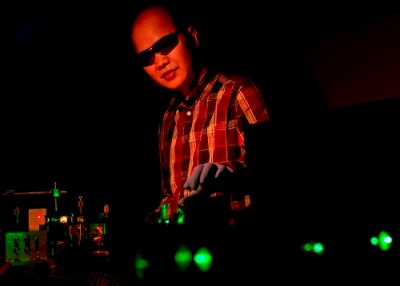A team led by Brown University researchers has developed an innovative prototype technology that can produce red, green and blue lasers from nanometer-sized semiconductor particles, paving the way to develop products, including high-performance digital displays that can use different laser colors simultaneously.
 Colloidal quantum dots -- nanocrystals -- can produce lasers of many colors. Cuong Dang manipulates a green beam that pumps the nanocrystals with energy, in this case producing red laser light (at left). (Credit: Mike Cohea/Brown University)
Colloidal quantum dots -- nanocrystals -- can produce lasers of many colors. Cuong Dang manipulates a green beam that pumps the nanocrystals with energy, in this case producing red laser light (at left). (Credit: Mike Cohea/Brown University)
These semiconductor particles are known as colloidal quantum dots or nanocrystals comprising a selenium-cadmium alloy inner core, proprietary organic molecular glue, and a cadmium-sulfur-zinc alloy coating. QD Vision manufactures these nanocrystals utilizing a wet chemistry method that can accurately produce different-sized nanocrystals by altering the production time. Nanocrystals of 4.2-nm size generate red light, 3.2-nm crystals release green light and 2.5-nm crystals emit blue light. Various sizes can emit other colors across the spectrum.
Cuong Dang, one of the researchers, stated that the structure of the nanocrystals and the outer cladding are vital in producing lasers using colloidal quantum dots. These coated pyramids generate laser light using 1,000-fold less power or 10-fold less pulsed energy when compared to earlier attempts. The outer cladding and the structure decreases destructive crosstalk and reduces the energy required to illuminate the quantum dots, which in turn decreases the energy needed for pumping the quantum dot laser and lowers the chance of surpassing the level of excitons wherein the Auger process draws off energy. Moreover, the novel structure of the new technique allows the dots to more rapidly emit light prior to the initiation of the Auger process.
To produce a laser, Dang used a viscous liquid of colloidal quantum dots brewed at QDVision as per the specifications of Brown University. He coated the liquid over glasses having different shapes and then evaporated. This results in numerous highly ordered and tightly packed nanocrystal layers on the glass surface. Dang then sandwiched the coated glass between two specially designed mirrors to produce a complex laser structure dubbed as a vertical-cavity surface-emitting laser (VCSEL).
The Brown University-led research team produced a working VCSEL for the first time using colloidal quantum dots.